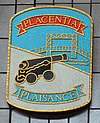Placentia, Newfoundland and Labrador
|
Placentia Pleasure Plaisance |
||
|---|---|---|
| Town | ||

Panorama of Placentia
|
||
|
||
| Location of Placentia in Newfoundland | ||
| Coordinates: 47°14′45″N 53°57′40″W / 47.24583°N 53.96111°W | ||
| Country |
|
|
| Province |
|
|
| Settled | early 16th century | |
| Government | ||
| • Mayor | Wayne Power Jr. | |
| Population (2011) | ||
| • Total | 3,643 | |
| Time zone | Newfoundland Time (UTC-3:30) | |
| • Summer (DST) | Newfoundland Daylight (UTC-2:30) | |
| Area code(s) | 709 | |
| Website | Official Town Website | |
Placentia is a town on the Avalon Peninsula, Newfoundland and Labrador, consisting of the amalgamated communities of Jerseyside, Townside, Freshwater, Dunville and Argentia. Common family names include Caul, Power, O'Keefe, Collins, O'Reilly, Murphy, Williams, Gambin, Hatfield, Wadman, Lake, Barry, Mooney, and Careen.
In the 2006 census, Placentia's population was reported as 3,898, down significantly from the 2001 figure of 4,426. This population decline has been ongoing since the early 1990s; in the 1996 census, Placentia was, proportionately, the 2nd fastest shrinking town in Canada, dropping from 5,515 to 5,013 between 1991 and 1996.
It is unclear when Placentia terrain was first settled by Europeans, but Basque fishermen were fishing in the area as early as the beginning of the 16th century, using Placentia as a seasonal centre of operations. The will of a Basque seaman has been discovered in an archive in Spain in which Domingo de Luca asks in 1563 “that my body be buried in this port of Plazençia in the place where those who die here are usually buried.” It is believed to be the oldest original civil document written in Canada. Contemporary scholars think that land called Vinland extending from Nova Scotia to L'Anse aux Meadows consisted at least a few settlements, probably on Avalon Peninsula too. "Placentia" may be derived from a similar name of an old Basque villa called Placencia de las Armas (Basque: Soraluze), which is located in the Gipuzkoa province of the Basque Country. Placentia may also be derived from the Latin placentia, a name also probably given by the Basques. Placentia's large, rocky beach meant that fish could be salted and dried on the beachrocks rather than on a constructed wooden fishing stage, saving both time and effort.
In 1655, the French, who controlled more than half of the island of Newfoundland, and most of Atlantic Canada, made Placentia (French: Plaisance) their capital. They built Fort Plaisance in 1662, which was followed by Fort Royal in 1687, and Fort Saint Louis in 1691. The establishment of a fort with a garrison allowed fishermen to pursue their activities with greater safety in neighbouring harbours. The French garrisons at Plaisance were small, but despite that fact, the soldiers and French privateers managed to hold their own in the face of numerous English attacks during the two major conflicts of the Nine Years' War and the War of the Spanish Succession, which marked the colony's history. In 1692, Louis-Armand de Lom d'Arce de Lahontan, Baron de Lahontan defended the French port.
...
Wikipedia


